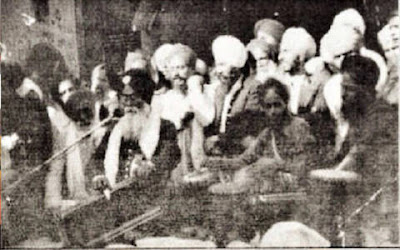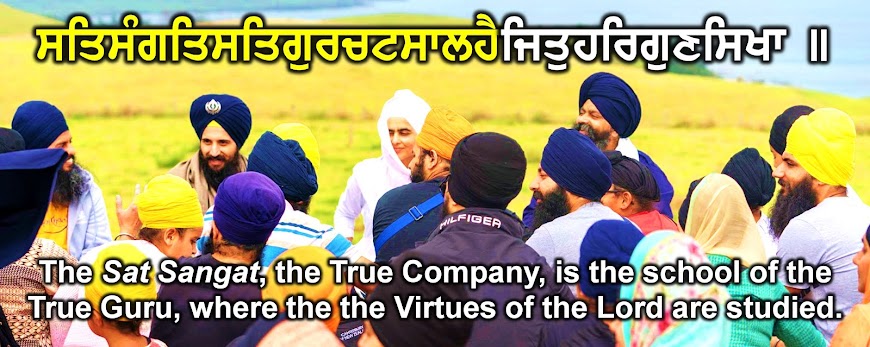A small write-up dedicated to the late Master Niranjan Singh Ji (Gurdaspur wale), a role model Gursikh that I was blessed to meet and spend time with in the Sangat. Master Ji left this world to the Guru's abode on 14th February 2019.
A SHORT GLIMPSE AT THE LIFE OF
MASTER NIRANJAN SINGH JI (GURDASPUR WALE)

Background
Master Niranjan Singh Ji was born in 1937 in a village in the district of Gurdaspur. Life was simple when he was growing up. There were no televisions and distractions. Before the partition of Punjab in 1947, Master Ji learned from Muslim teachers who taught him math, as well as how to read and write. They were very strict, and would beat students if they made mistakes. However, they taught him to write Gurmukhi beautifully. This would later go on to help him as he would write a complete Saroop of Sri Guru Granth Sahib Ji by hand. Master Ji attended DAB school in the village Dhaliwal for grade 5. From grade 6 to 10 he studied at a local Khalsa School. He was very intelligent and would regularly score first in his class. For this reason, other students knew him as "First". He finished High School (Grade 10) in 1953. In 1954 he trained to become a teacher at a school near Jagraaon at this point he was 17/18 years old. In 1955 he became a teacher, first teaching in a primary school and then teaching Punjabi. Master Ji also completed his BA and Giani certification. Master Ji retired from his teaching job in 1995 at Gurdaspur Senior Secondary School, teaching Punjabi for 40 years.

Meeting the Holy Saint
Master Ji was in grade 10 when he took Amrit. He had memorized some Bani from a young age as he had an interest in studying and learning rather than in playing. When he had taken Amrit he was not aware of the Rehat he needed to keep. He didn’t know that he needed to wear all the Panj Kakkars or even which Banis to do read daily. He says some local village Paathis had done the Amrit Sanchar without much effort to ensure the Abhilakhis were prepared to live a Guru-centered life. When Master Ji attended his teacher training he met a Gursikh whose father taught in the village Mohi, near Narangvaal, which was Bhai Sahib Bhai Randhir Singh Ji’s Pind. This Gursikh asked Master Ji if he was Amritdhari to which Master Ji replied that he was. So, the Gursikh asked where his Kirpan was. Master Ji asked him if wearing a Kirpan was mandatory, and the Gursikh being taken aback said “Yes! It is very important. Wearing all 5 Kakkars is extremely important!” The Gursikh then asked Master Ji which Banis he read as his Nitnem. Master Ji replied that he read Jap Ji Sahib, Rehras Sahib and Kirtan Sohila. The Gursikh then explained to Master Ji that he must do 5 Banis in the morning and 2 in the evening and night time. Master Ji says that this was all shocking to him but he accepted the Gursikh’s bachan. Master Ji and the Gursikh would then daily do their Nitnem. After a while the Gursikh brought Master Ji to Poh Sudi Saptami Smagam at Narangvaal. Master Ji attended the Rainsbaaee where he heard Bhai Sahib Randhir Singh Ji do Kirtan. Bhai Sahib was a saint, soldier, scholar, mystic, and kirtani, who had been honored by all Takhat Sahibs for his contribution to the Sikh nation and his high Gurmat character. Bhai Sahib did Kirtan for 2.5-3 hours. He sang in a high-pitched tone, which captured the hearts of everyone who heard the Kirtan. The one line Bhai Sahib sang over and over was:
ਜਨਮ ਜਨਮ ਕਾ ਵਿਛੁੜਿਆ ਹਰਿ ਮੇਲਹੁ ਸਜਣੁ ਸੈਣ॥
"Through countless lifetimes and incarnations, I was separated from Him. O Lord, you are my Friend and Companion-please unite me with Yourself."
Sangat with Shaheed Bhai Fauja Singh Ji
Master Niranjan Singh first met Bhai Fauja Singh in 1963 and remained friends with him until his Shaheedi in 1978. Master Ji then became close to Bhai Fauja Singh and his family. Bhai Fauja Singh’s mother showed him a lot of love, treating him like her own son. From then on Master Ji would stop by every evening after work to eat and do Kirtan. Master Ji and Bhai Fauja Singh spent many days together doing Kirtan and Naam Abhiaas. At times they would go out into the fields and would fall asleep doing Kirtan and Abhiaas. In the morning at Amritvela they would again rise and do Abhiaas together. In 1977 Bhai Fauja Singh founded Khalsa Farm, which was the first kind of modern-day Gurmat camp where Sangat were trained in a Gursikhi way of life. They would wake up at 2 AM doing Abhiaas, Nitnem and Asa di Vaar Kirtan. During the day they would do Gurmat Vichaar, Gatka and more Kirtan. Master Niranjan Singh Ji would accompany Bhai Fauja Singh Ji's group (Chalda Vaheer Jatha) from village to village to spread the message of Guru Nanak Dev Ji through Kirtan, Gurmat Vichaar, and Shastar Vidiya (martial arts). Mata Amarjit Kaur Ji (wife of Bhai Fauja Singh) mentions that Master Ji was Bhai Fauja Singh Ji's favourite Kirtani.

Amrit-Vela
Master Ji was very strict about Amrit-vela Naam Abhiaas (Practice). During Amrit Sanchaars. Master Ji was so strict on the Sevadaars and Abhilakhis about doing 2.5 hours of Abhiaas every day. He would say that 2.5 hours a day of Abhiaas (practice of Naam) is mandatory, it’s our lekha (account given) to Guru Sahib, after 2.5 hours is where our real Kamaee (earning spiritual wealth) starts. When asked if it is okay to do Jaap of Vahiguru (known as 'Dhuni') in Kirtan, Master Ji said all the Kirtani of the past that he had seen do Kirtan did Vahiguru Jaap in Kirtan. However, he said those Kirtani used to do over 2.5 hours of Naam Abhiaas daily at Amrit-vela. Hearing such Gurmukhs do Simran in Kirtan was a blessed moment. However, Master Ji warned others of doing Vahiguru Jaap in Kirtan in Sangat when we ourselves have not followed Hukam of Guru Sahib of doing Naam Abhiaas at Amrit-Vela. Master Ji said there is no restriction on doing Simran in Kirtan, however we should first drench ourselves in Gurbani and if after this the Simran happens then it happens, but we should not force it.

Love for Kakkaars
When Master Niranjan Singh Ji visited Australia in 2005, he was very exhausted and weak when he arrived at the airport and nearly collapsed. The reason for Master Ji's weakness was due to him not drinking or eating anything throughout the whole journey. Master Ji had travelled from USA to Australia and it was a long journey. However, Master Ji, like many Sidaki (faithful) Gursikhs, refused to drink or eat anything as a form of protest of not being able to wear his Kirpan on the journey. If someone has so much Pyaar for the Kirpan, imagine how much Pyaar they must have for the one who blessed them with the Kirpan. On receiving the Kirpan on arrival, Master Ji only ate and drank after doing Paath and Ardaas for forgiveness that his Kakkaars had been separated from him.
Khalsa Camps
The first-ever Khalsa Camp in Canada took place in BC in 2010. Master Niranjan Singh Ji, along with Bhai Bharpoor Singh Ji were an integral part of the camp and gave encouragement to the organisers to hold such camps. I remember Master Ji saying, "this is a training a camp." He believed as Sikhs we are the army of Guru Ji, and we need to become disciplined in the way we dress, speak, talk, walk, eat etc. He would tell campers to truly accept and see Sri Guru Granth Sahib Ji as the King of Kings and for this reason to dress as such in the Guru's Darbaar. Master Ji would tell all campers and sevadaars to refrain from wearing shorts, t-shirts, and other such clothes in the Guru's Darbaar and instead wear Gurmukhi-attire to respect the True King, Sri Guru Granth Sahib Ji. Master Ji was always really approachable to all campers and sevadaars. He was like everyone’s father and grandfather.Master Ji spent many years abroad visiting countries doing Gurmat Parchar. His presence has especially been felt in Canada, USA and UK. His Seva at Smagams and Camps has helped bring many on to the path of Gursikhi.

Leaving the world for the Guru's Abode (Gurpuri)
On Thursday 14th February 2019, at the age of 82, Master Niranjan Singh Ji left his earthly body. Master Niranjan Singh Ji’s passing was felt worldwide by Gursikhs he had impacted through his Gursikhi Jeevan. Master Ji had lived Gurmat embodying many Gurmukhi gunns (qualities) such as humility, sweet speech, compassion, steadfastness in Gurmat, amongst many others. He was a Naam imbued soul and the definition of a Gursikh. He lived his life in the service and love of Guru Sahib, and he lived within Gurmat until the end. For such Gursikhs there are so many Shabads within Gurbani but let us reflect on the following as we remember our Pyare Pyare Master Niranjan Singh Ji:
ਜਿਨ ਹਰਿ ਮਨਿ ਵਸਿਆ ਸੇ ਦਰਿ ਸਾਚੇ ਦਰਿ ਸਾਚੈ ਸਚਿਆਰਾ॥
ਓਨਾ ਦੀ ਸੋਭਾ ਜੁਗਿ ਜੁਗਿ ਹੋਈ ਕੋਇ ਨ ਮੇਟਣਹਾਰਾ॥
ਨਾਨਕ ਤਿਨ ਕੈ ਸਦ ਬਲਿਹਾਰੈ ਜਿਨ ਹਰਿ ਰਾਖਿਆ ਉਰਿਧਾਰਾ॥੮॥੧॥
Those whose minds are filled with the Lord are judged as true in the Court of the Lord; they are hailed as true in the True Court. Their praises echo throughout the ages, and no one can erase them. Nanak is forever a sacrifice to those who enshrine the Lord within their hearts. ||8||1||





















































